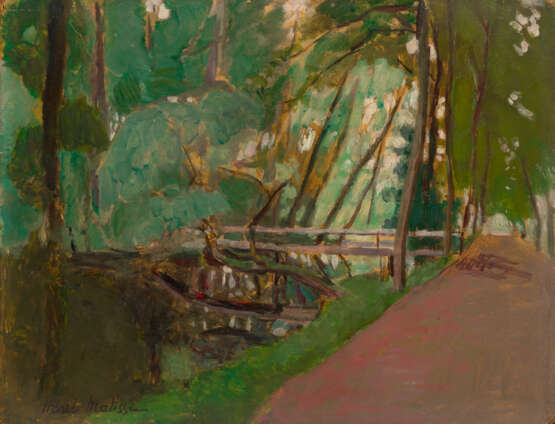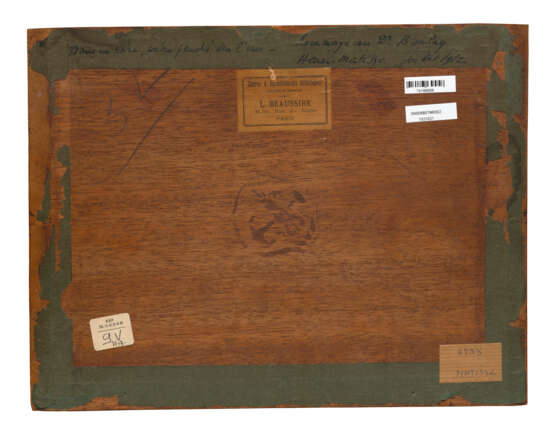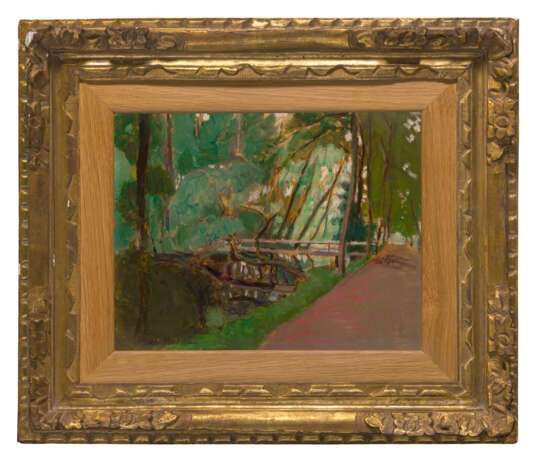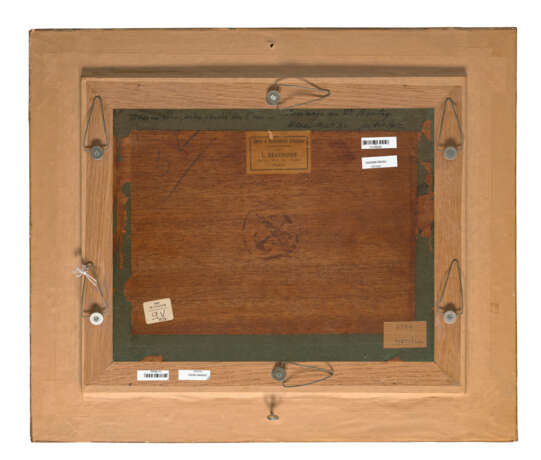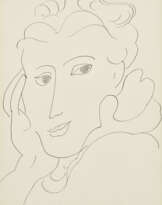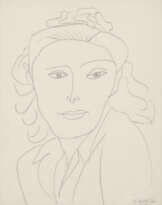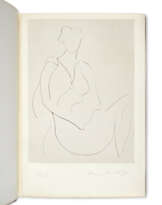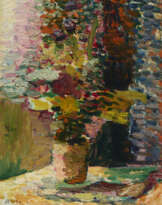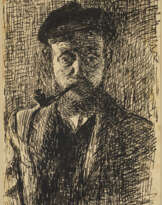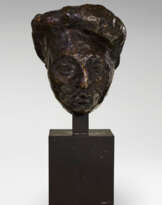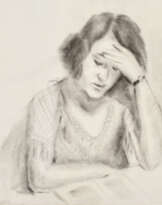ID 1400247
Lot 334 | Henri Matisse (1869-1954)
Estimate value
€ 100 000 – 150 000
Sous-bois
signé 'Henri Matisse' (en bas à gauche); signé et inscrit 'Dans un parc, arbre penché sur l'eau - hommage au Dr Boulay Henri Matisse, juillet 1912' (au revers)
huile sur papier marouflée sur panneau
24 x 31.1 cm.
Peint vers 1902-03
signed 'Henri Matisse' (lower left); signed, dated and inscribed 'Dans un parc, arbre penché sur l'eau - hommage au Dr Boulay Henri Matisse, juillet 1912 (on the reverse)
oil on paper laid down on panel
9 ½ x 12 ¼ in.
Painted circa 1902-03
Provenance
Collection Docteur Boulay, France (acquis auprès de l'artiste en 1912).
Vente, Mes Rieunier, Bailly et Pommery, Paris, 16 juin 1997, lot 49.
Acquis au cours de cette vente par la famille du propriétaire actuel.
Further details
Après leur mariage en janvier 1898, Henri Matisse et sa nouvelle épouse Amélie Parayre passent leur lune de miel à Londres, principalement pour admirer les peintures de Joseph Mallord William Turner, sur la suggestion de Camille Pissarro.
En découvrant les œuvres de Turner en personne, Matisse voit non seulement la lumière d'une manière nouvelle, mais aussi un moyen de donner à la beauté, un sens plus onirique, intense et enraciné dans la nature sans pour autant la représenter servilement.
Fort de cette nouvelle découverte, Matisse se rend en Corse et, pour la première fois, se consacre pleinement à la création artistique. « La peinture, à supposer qu'elle ait été académique, permettait à peine de vivre à l'époque. J'allais être obligé d'exercer un autre métier », explique Matisse. « J'ai décidé de me donner une année de congé, sans entraves, pendant laquelle je peindrai à ma guise. Je ne travaillais plus que pour moi. J'étais sauvé. » (cité dans H. Spurling, The Unknown Matisse : A Life of Henri Matisse, 1869-1908, New York, 1998, vol. 1, p. 159).
En février 1899, Matisse et son épouse Amélie rentrent à Paris après une année à parcourir Londres, la Corse et Toulouse au lendemain de leurs noces. Ils y trouvent un appartement dans le même immeuble qu'Albert Marquet, grand ami de Matisse, au 19 quai Saint-Michel, où ils vivront jusqu'en 1907.
Avec ses généreux aplats de couleurs vives, Sous-bois préfigure la période fauve de Matisse et témoigne, déjà, du sens extraordinaire des nuances et des contrastes qui fera de lui le plus grand coloriste du XXe siècle.
S'il faut attendre 1905 pour que le terme « fauvisme » fasse son entrée dans le monde de l'art, André Derain affirmera avec le recul qu'« à partir de 1900 environ, une sorte de fauvisme s'est imposé » ; quant à Marquet, il estime que les premiers balbutiements du mouvement apparaissant plus tôt encore : « Dès 1898, Matisse et moi travaillions dans ce qui allait être appelé plus tard la manière fauve. Les premiers Indépendants, où je crois que nous étions les deux seuls peintres à nous exprimer en tons purs, étaient en 1901 » (cité dans J. Elderfield, The 'Wild Beasts' Fauvism and its Affinities, New York, 1976, p. 18).
Peint aux prémices de sa carrière, Sous-bois est emblématique de la période de mutation radicale qui voit l'expression de Matisse se détourner du néo-impressionnisme pour glisser vers une facture beaucoup plus « fauve ». Le contraste volontairement tranchant entre les étendues de couleurs vibrantes, traitées de façon uniforme, ainsi que la structure d'ensemble aux forts accents géométriques et abstraits, annoncent la manière révolutionnaire dont Matisse fera bientôt de la toile une surface dépourvue de relief : un plan de tous les possibles, purement consacré à sa maîtrise virtuose de la couleur.
After marrying in January 1898, Matisse and his new bride Amélie Parayre spent their honeymoon in London mainly to view J.M.W. Turner’s paintings on the suggestion of Camille Pissarro. In seeing Turner’s works in person, Matisse found a new appreciation of light and moved away from Impressionism. In Turner, Matisse saw not only light, but a means of creating an intense dreamlike sense of beauty rooted in but not slavishly representing nature. With this newfound discovery, Matisse traveled to Corsica and for the first time devoted himself fully to creating art. “Painting, even supposing it had been academic painting, could barely provide a living in those days. I was going to be forced to take up some other job” explained Matisse. “I decided to give myself a year off, without impediments, in which I would paint as I wanted to. I no longer worked for anyone but myself. I was saved.” (quoted in H. Spurling, The Unknown Matisse: A Life of Henri Matisse, 1869-1908, New York, 1998, vol. 1, p. 159).
In February 1899, Matisse and his new bride Amélie returned to Paris having spent a year traveling to London, Corsica and Toulouse. They took an apartment in the same building as Matisse's closest friend Albert Marquet, at 19 Quai St. Michel, where they lived until 1907.Imbued with flat areas of vibrant colors, Sous-bois foreshadows Matisse's Fauve period and is an early indication of his status as the foremost colorist of the 20th century. Although the term "Fauvism" was not coined until 1905, fellow painter André Derain later claimed "From around 1900 a kind of fauvism held sway" while Marquet similarly dated its beginnings "as early as 1898 [when] Matisse and I were working in what was later called the fauve manner. The first showing of the Indépendants in which, I believe, we were the only painters to express ourselves in pure colours, took place in 1901" (quoted in J. Elderfield, The 'Wild Beasts' Fauvism and its Affinities, New York, 1976, p. 18).
Painted early on in his career, Sous-bois epitomizes Matisse's vital transition from painting in the Neo-Impressionist style toward Fauvism. The deliberate contrast between the brilliant colors, the tonal uniformity and lack of modulation in the color planes, and the architecture broken down into nearly abstract, geometric forms all hint at Matisse's later revolutionary flattening of the picture plane and firmly establish his unrivaled mastery of colour.
| Artist: | Henri Matisse (1869 - 1954) |
|---|---|
| Applied technique: | Oil on panel |
| Place of origin: | Western Europe, France, Europe |
| Auction house category: | Paintings, Watercolors, Drawings, Paintings |
| Artist: | Henri Matisse (1869 - 1954) |
|---|---|
| Applied technique: | Oil on panel |
| Place of origin: | Western Europe, France, Europe |
| Auction house category: | Paintings, Watercolors, Drawings, Paintings |
| Address of auction |
CHRISTIE'S 8 King Street, St. James's SW1Y 6QT London United Kingdom | |
|---|---|---|
| Preview |
| |
| Phone | +44 (0)20 7839 9060 | |
| Buyer Premium | see on Website | |
| Conditions of purchase | Conditions of purchase |
